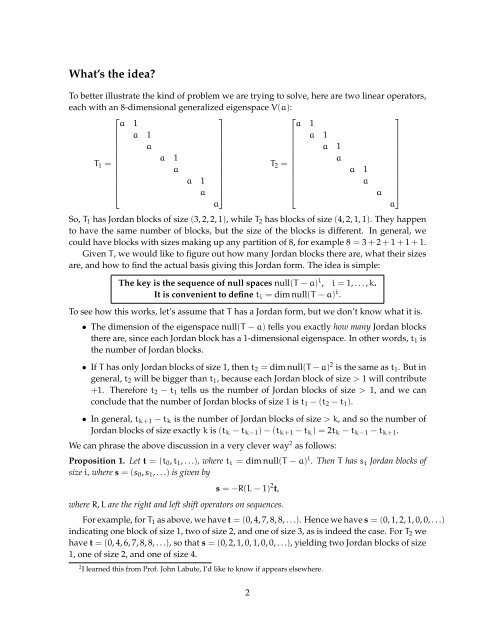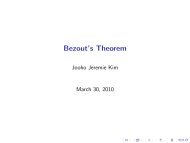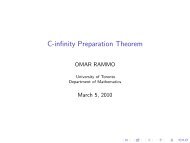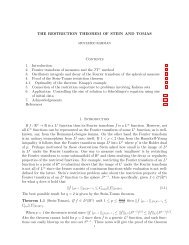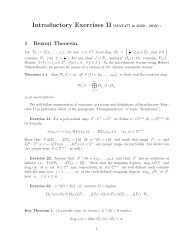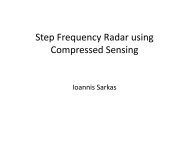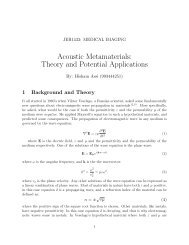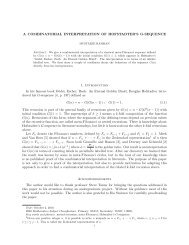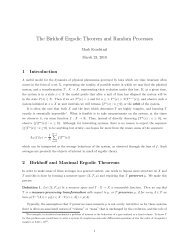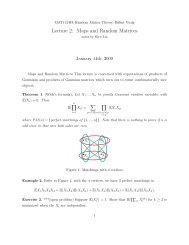Notes on the Jordan canonical form Introduction - wiki - University of ...
Notes on the Jordan canonical form Introduction - wiki - University of ...
Notes on the Jordan canonical form Introduction - wiki - University of ...
Create successful ePaper yourself
Turn your PDF publications into a flip-book with our unique Google optimized e-Paper software.
What’s <strong>the</strong> idea?<br />
To better illustrate <strong>the</strong> kind <strong>of</strong> problem we are trying to solve, here are two linear operators,<br />
each with an 8-dimensi<strong>on</strong>al generalized eigenspace V(a):<br />
⎡<br />
a 1<br />
⎤<br />
⎡<br />
a 1<br />
⎤<br />
⎢<br />
T1 = ⎢<br />
⎣<br />
a 1<br />
a<br />
a 1<br />
a<br />
a 1<br />
a<br />
⎥<br />
⎦<br />
⎢<br />
T2 = ⎢<br />
⎣<br />
a 1<br />
a 1<br />
a<br />
a 1<br />
a<br />
a<br />
⎥<br />
⎦<br />
a<br />
a<br />
So, T1 has <strong>Jordan</strong> blocks <strong>of</strong> size (3, 2, 2, 1), while T2 has blocks <strong>of</strong> size (4, 2, 1, 1). They happen<br />
to have <strong>the</strong> same number <strong>of</strong> blocks, but <strong>the</strong> size <strong>of</strong> <strong>the</strong> blocks is different. In general, we<br />
could have blocks with sizes making up any partiti<strong>on</strong> <strong>of</strong> 8, for example 8 = 3 + 2 + 1 + 1 + 1.<br />
Given T, we would like to figure out how many <strong>Jordan</strong> blocks <strong>the</strong>re are, what <strong>the</strong>ir sizes<br />
are, and how to find <strong>the</strong> actual basis giving this <strong>Jordan</strong> <strong>form</strong>. The idea is simple:<br />
The key is <strong>the</strong> sequence <strong>of</strong> null spaces null(T − a) i , i = 1, . . . , k.<br />
It is c<strong>on</strong>venient to define ti = dim null(T − a) i .<br />
To see how this works, let’s assume that T has a <strong>Jordan</strong> <strong>form</strong>, but we d<strong>on</strong>’t know what it is.<br />
• The dimensi<strong>on</strong> <strong>of</strong> <strong>the</strong> eigenspace null(T − a) tells you exactly how many <strong>Jordan</strong> blocks<br />
<strong>the</strong>re are, since each <strong>Jordan</strong> block has a 1-dimensi<strong>on</strong>al eigenspace. In o<strong>the</strong>r words, t1 is<br />
<strong>the</strong> number <strong>of</strong> <strong>Jordan</strong> blocks.<br />
• If T has <strong>on</strong>ly <strong>Jordan</strong> blocks <strong>of</strong> size 1, <strong>the</strong>n t2 = dim null(T − a) 2 is <strong>the</strong> same as t1. But in<br />
general, t2 will be bigger than t1, because each <strong>Jordan</strong> block <strong>of</strong> size > 1 will c<strong>on</strong>tribute<br />
+1. Therefore t2 − t1 tells us <strong>the</strong> number <strong>of</strong> <strong>Jordan</strong> blocks <strong>of</strong> size > 1, and we can<br />
c<strong>on</strong>clude that <strong>the</strong> number <strong>of</strong> <strong>Jordan</strong> blocks <strong>of</strong> size 1 is t1 − (t2 − t1).<br />
• In general, tk+1 − tk is <strong>the</strong> number <strong>of</strong> <strong>Jordan</strong> blocks <strong>of</strong> size > k, and so <strong>the</strong> number <strong>of</strong><br />
<strong>Jordan</strong> blocks <strong>of</strong> size exactly k is (tk − tk−1) − (tk+1 − tk) = 2tk − tk−1 − tk+1.<br />
We can phrase <strong>the</strong> above discussi<strong>on</strong> in a very clever way 2 as follows:<br />
Propositi<strong>on</strong> 1. Let t = (t0, t1, . . .), where ti = dim null(T − a) i . Then T has si <strong>Jordan</strong> blocks <strong>of</strong><br />
size i, where s = (s0, s1, . . .) is given by<br />
s = −R(L − 1) 2 t,<br />
where R, L are <strong>the</strong> right and left shift operators <strong>on</strong> sequences.<br />
For example, for T1 as above, we have t = (0, 4, 7, 8, 8, . . .). Hence we have s = (0, 1, 2, 1, 0, 0, . . .)<br />
indicating <strong>on</strong>e block <strong>of</strong> size 1, two <strong>of</strong> size 2, and <strong>on</strong>e <strong>of</strong> size 3, as is indeed <strong>the</strong> case. For T2 we<br />
have t = (0, 4, 6, 7, 8, 8, . . .), so that s = (0, 2, 1, 0, 1, 0, 0, . . .), yielding two <strong>Jordan</strong> blocks <strong>of</strong> size<br />
1, <strong>on</strong>e <strong>of</strong> size 2, and <strong>on</strong>e <strong>of</strong> size 4.<br />
2 I learned this from Pr<strong>of</strong>. John Labute, I’d like to know if appears elsewhere.<br />
2


